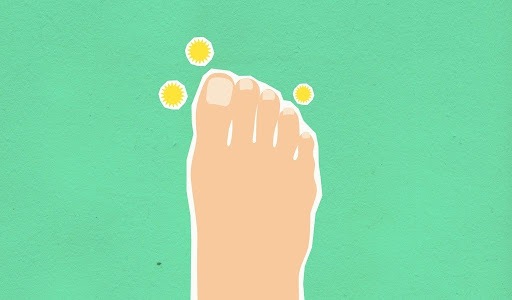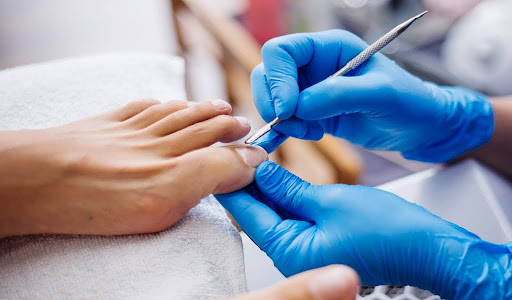Utah Becomes the First State to Let AI Handle Prescription Refills
Utah just made history: it's the first US state to let an AI system renew prescriptions on its own. The program covers people who are already taking medications for [...]
Read More
Medically reviewed by Oghenefejiro Okifo | MD, Harvard Medical School | Henry Ford Hospital - Detroit, MI on June 6th, 2025.
Understanding the health of your nails can provide critical insights into your overall well-being. Among the various conditions that can affect toenails, toenail hematomas and melanomas are two that often cause concern. While they may appear similar at first glance, they have distinct causes, symptoms, and implications for health. This article aims to clarify the differences between toenail hematomas and melanomas, helping you recognize what might be lurking beneath your nail.
 What is a Toenail Hematoma?
What is a Toenail Hematoma?A toenail hematoma is a localized collection of blood underneath the nail, often resulting from trauma or injury. It occurs when small blood vessels break, leading to blood pooling beneath the nail plate. This condition can be quite painful and may change the color of the nail to shades of red, purple, or black. In some instances, the pressure from the accumulated blood can be intense enough to cause significant discomfort, prompting individuals to seek medical attention.
Toenail hematomas are primarily caused by physical trauma. Common causes include:
Dropping a heavy object on the toe
Stubbing the toe against a hard surface
Wearing ill-fitting shoes that place excessive pressure on the toenails
In some cases, repetitive trauma from activities such as running or jumping can also lead to the development of a hematoma. Athletes, particularly runners and dancers, are often at risk due to the constant impact and friction on their toenails. Understanding these causes can help in taking preventive measures to protect your toenails. For instance, choosing footwear that provides proper support and cushioning can significantly reduce the likelihood of injury.
The most noticeable symptom of a toenail hematoma is the discoloration of the nail, which can range from red to dark purple. Other symptoms may include:
Pain or tenderness in the affected toe
Swelling around the nail
In severe cases, the nail may separate from the nail bed
Diagnosis typically involves a physical examination. A healthcare provider may ask about recent injuries or activities that could have caused the trauma. In some cases, imaging tests may be conducted to assess the extent of the injury.
Additionally, the doctor may inquire about any underlying conditions, such as blood clotting disorders, that could exacerbate the situation. It’s important to monitor the symptoms closely, as complications such as infection or permanent nail damage can occur if the hematoma is not treated appropriately.
In cases where the hematoma is particularly large or painful, a procedure called trephination may be performed. This involves creating a small hole in the nail to relieve pressure and allow the trapped blood to escape. This can provide immediate relief from pain and prevent further complications. After the procedure, proper care and hygiene are essential to ensure the area heals correctly and to prevent infection.
Treatment for a toenail hematoma largely depends on the severity of the condition. In many cases, the hematoma will resolve on its own, but there are several options available to alleviate pain and promote healing.
For minor hematomas, home care can be effective. Recommended practices include:
Rest the affected foot and avoid activities that put pressure on the toe.
Applying ice to reduce swelling and numb the pain.
Elevating the foot minimizes blood flow to the area.
These measures can help manage symptoms and promote recovery. However, if the pain persists or worsens, further medical intervention may be necessary.
Additionally, over-the-counter pain relievers such as ibuprofen or acetaminophen can be used to help alleviate discomfort. It is also advisable to keep the toenail clean and dry to prevent any potential infection while it heals. If the hematoma is accompanied by a fracture or other injury, it is crucial to seek medical attention promptly to address any underlying issues.
In cases where the hematoma is extensive or painful, a healthcare provider may perform a procedure to relieve pressure. This might involve:
Draining the blood from beneath the nail using a sterile needle.
In more severe cases, partial or complete nail removal may be required.
It is essential to follow up with a healthcare professional to ensure proper healing and to monitor for any complications. After any medical intervention, it’s important to adhere to post-procedure care instructions. This may include keeping the area clean, applying topical antibiotics to prevent infection, and possibly wearing protective footwear to avoid further trauma. Patients should also be aware of the signs of infection, such as increased redness, swelling, or discharge, and seek medical advice if these occur. Regular check-ups may be necessary to assess the healing process and to determine if any additional treatments are needed.
Unlike a hematoma, toenail melanoma is a type of skin cancer that can occur under the nail. It is a serious condition that requires prompt diagnosis and treatment. Melanoma can develop in the nail matrix, the tissue under the nail, and may present as a dark streak or spot. This condition is particularly insidious because it can often be mistaken for other benign nail conditions, leading to delays in diagnosis and treatment. Early detection is crucial, as toenail melanoma can metastasize, spreading to other parts of the body if not treated in a timely manner.
The exact cause of toenail melanoma is not fully understood, but several risk factors have been identified:
Excessive sun exposure, particularly to the feet and toes.
A family history of melanoma or other skin cancers.
Having a fair complexion or a history of skin conditions.
While anyone can develop melanoma, those with a higher risk should be vigilant about monitoring their nails for changes.
Additionally, individuals who engage in activities that expose their feet to the sun, such as beach outings or outdoor sports, should take extra precautions. Wearing protective footwear and applying sunscreen to the feet can help mitigate some of the risks associated with sun exposure.
Symptoms of toenail melanoma can vary but often include:
A dark brown or black streak under the nail that may expand over time.
Changes in the shape or texture of the nail.
Separation of the nail from the nail bed.
Diagnosis typically involves a thorough examination by a dermatologist. A biopsy may be performed to confirm the presence of cancerous cells. In some cases, advanced imaging techniques may be utilized to determine the extent of the disease. Patients should be aware that even subtle changes in their toenails should not be ignored, as early intervention can significantly improve outcomes. Regular self-examinations and professional check-ups are essential, especially for those in high-risk categories.
 Early detection is crucial for effective treatment of toenail melanoma. The treatment plan may vary based on the stage of the cancer and the individual’s overall health.
Early detection is crucial for effective treatment of toenail melanoma. The treatment plan may vary based on the stage of the cancer and the individual’s overall health.
The primary treatment for toenail melanoma is surgical removal of the cancerous tissue. This may involve:
Excision of the melanoma along with a margin of healthy tissue to ensure complete removal.
In cases of advanced melanoma, amputation of the toe may be necessary.
Post-surgery, patients may require follow-up treatments such as immunotherapy or chemotherapy, depending on the extent of the disease. These additional therapies aim to target any remaining cancer cells and bolster the body’s immune response. Immunotherapy, in particular, has shown promise in enhancing the body’s ability to fight off melanoma cells, even in cases where the cancer has spread beyond the initial site.
After treatment, regular follow-up appointments are essential to monitor for any signs of recurrence. Dermatologists may recommend periodic skin checks to ensure the health of the surrounding skin and nails. During these visits, patients may undergo dermatoscopic examinations, which allow for a detailed view of the skin and nails, helping to identify any suspicious changes early on.
Additionally, patients are encouraged to perform self-examinations at home, looking for any new moles or changes in existing ones, as early detection remains a key factor in successful outcomes.
Education about the risk factors associated with toenail melanoma is also vital. Individuals with a history of excessive sun exposure, those with fair skin, or those who have had previous skin cancers should be particularly vigilant.
Furthermore, understanding the importance of protective measures, such as wearing sunscreen and protective footwear, can significantly reduce the risk of developing further skin issues. Engaging in discussions with healthcare providers about personal risk factors and preventive strategies can empower patients and enhance their overall approach to skin health.
While toenail hematomas and melanomas can present with similar visual symptoms, several key differences can help distinguish between the two:
Toenail Hematoma
From Trauma or injury
Red, purple, or black
Often painful
Home care, drainage, or nail removal
Generally good with proper care
Toenail Melanoma
From Skin cancer
Dark brown or black streak
May be painless
Surgical removal, possible chemotherapy
Varies; early detection is crucial
It is essential to monitor any changes in your toenails closely. While toenail hematomas may resolve with home care, there are specific signs that warrant immediate medical attention:
Severe pain that does not improve with rest and ice.
Signs of infection, such as increased redness, swelling, or pus.
Changes in the nail that persist or worsen over time, especially if a dark streak appears.
For toenail melanomas, early diagnosis is critical. Any suspicious changes in the nail should prompt an immediate visit to a healthcare professional.
Maintaining healthy toenails can help prevent both hematomas and melanomas. Here are some preventive measures to consider:
Wearing properly fitted shoes is essential. Shoes that are too tight or too loose can cause trauma to the toenails, leading to hematomas. Consider the following:
Choose shoes with a wide toe box to reduce pressure on the toes.
Opt for cushioned footwear, especially during high-impact activities.
For those at risk of melanoma, protecting the feet from sun exposure is crucial. Recommendations include:
Wear sunscreen on the tops of the feet and toes when exposed to sunlight.
Wear sandals or shoes that provide coverage.
Maintaining good nail hygiene can also help prevent issues. This includes:
Trimming nails straight across to avoid ingrown toenails.
Keeping nails clean and dry to prevent infections.
Understanding the differences between toenail hematomas and melanomas is vital for maintaining nail health. While hematomas are typically benign and related to trauma, melanomas pose a serious health risk that requires prompt attention. By recognizing symptoms, seeking appropriate medical care, and adopting preventive measures, individuals can safeguard their toenail health and overall well-being.
Don’t ignore the signs beneath your nails—your health deserves attention! A dark streak or spot under your nail could be a harmless hematoma or a serious melanoma. Take charge of your well-being today by asking Doctronic to uncover the truth—it’s always better to know!
Dark nail discoloration with a clear trauma history and pain typically indicates a benign hematoma that will resolve naturally, while painless expanding streaks warrant immediate medical assessment to rule out cancer. If you're experiencing unexplained nail changes or have concerns about existing discoloration, Doctronic can provide personalized guidance to help determine your next steps.
Utah just made history: it's the first US state to let an AI system renew prescriptions on its own. The program covers people who are already taking medications for [...]
Read MoreUnderstanding Mounjaro and Its UsesMounjaro is a prescription medication commonly prescribed for managing type 2 diabetes. It belongs to a class of drugs that help regulate [...]
Read MoreUnderstanding Hydrocortisone Uses and DosagesHydrocortisone is a versatile medication primarily used to reduce inflammation and suppress the immune system in various [...]
Read More